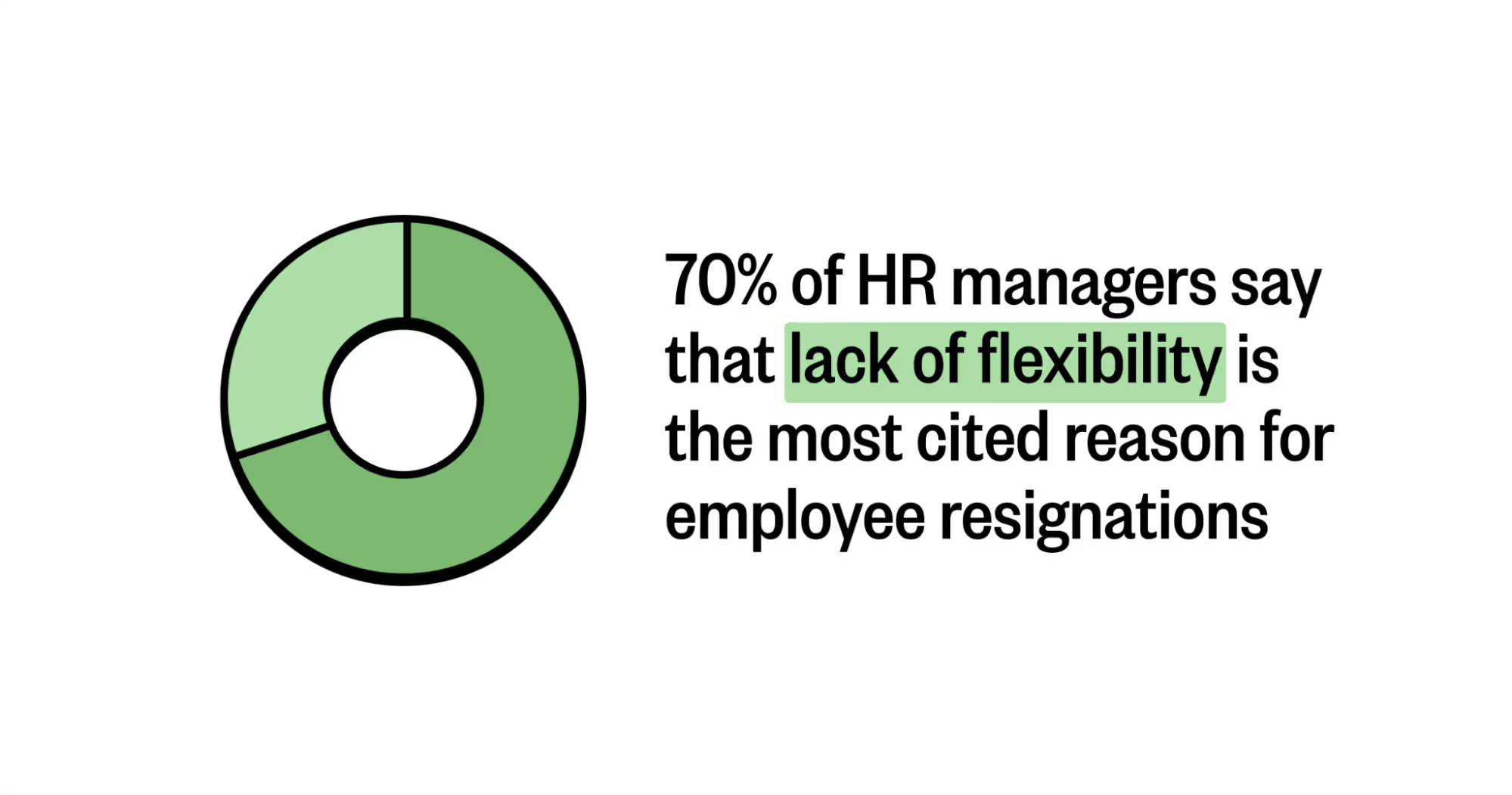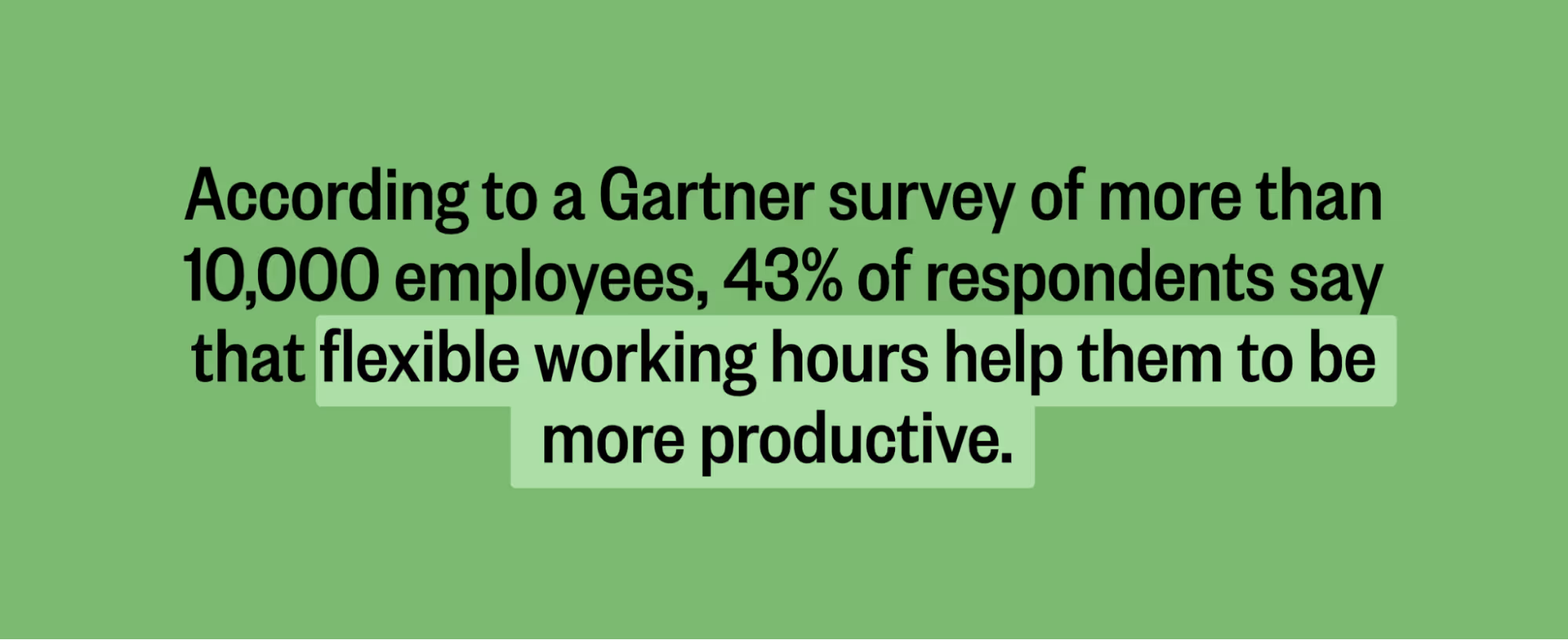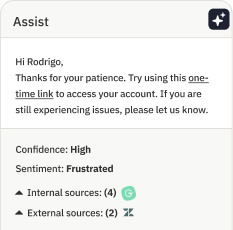Create the flexible work arrangements your support team needs (in 5 steps)

For customer support agents, scheduling a visit to the dentist can feel like an impossible feat. Available times are nearly always in the middle of their workdays, leaving them with few options aside from taking PTO or faking a sick day — just to keep their teeth clean. 🪥
It doesn’t have to be this way. It’s possible to develop an environment that allows employees the flexibility they deserve without sacrificing performance. There are certainly some logistics involved when it comes to making this approach work for customer support, but it’s completely doable with the right attitude and the right tools.
There are some undeniable benefits to developing flexible work arrangements that you should consider. From there, you can dive right into the step-by-step process of creating a flexible work environment. Let’s get started.
Why a flexible working system is so important
It’s easy to recognize that today’s workers need flexibility, but you may not realize how critical of a factor it’s become. Having the ability to accommodate life’s many demands is something that employees don’t just want but expect. This became quite clear during the onset of the “Great Resignation,” a trend that’s seen huge volumes of people quit jobs that aren’t supporting their needs.
In fact, a record number of employees quit their jobs in 2021. The trend shows no signs of stopping, either. Recent data from the U.S. Bureau of Labor Statistics reveals that the number of Americans leaving their jobs each month continues to remain above 4 million people.
While the Great Resignation is affecting nearly every industry and every type of organization, some are more vulnerable than others. This includes — you guessed it 🧠 — customer support.
Turnover has always been somewhat of a concern in the customer support space. The experts at the International Customer Management Institute (ICMI) say the typical turnover rate for call centers has been more than 30% for years. Bear in mind, that was prior to the Great Resignation. More recently? According to a 2021 study, the rate of agent turnover among call centers was 58% year over year. This means you could need to hire more than half of your current workforce every year just to keep your staff level the same.
Obviously, not everyone who said so long to a job in the last few years quit for the same reasons. But you might be surprised at how often lack of flexibility has been the tipping point. A survey from GoodFirms reveals that 70% of HR managers surveyed say that lack of flexibility is the most cited reason for resignations.

This is especially true for working parents. In many cases, flexibility is essential for juggling childcare responsibilities. There’s data to support this, with research from McKinsey & Company showing that parents are more likely to leave their jobs, particularly if they’re people of color. Women are also disproportionately affected — research from the Center for Global Development shows they’re much more likely to be tasked with managing their family’s childcare needs.
It’s also important to recognize that flexible work environments don’t just benefit employees — they’re also good for business. Here are a few advantages that the Society for Human Resource Management (SHRM) lays out:
- Helps recruiting efforts
- Enhances employee morale
- Reduces absenteeism
- Improves retention
- Boosts productivity
It’s also important to note that, as Zendesk points out, offering more flexible options can improve diversity in organizations. It’s not just a win-win, it’s a win6 at least.
How to develop a flexible work environment for customer support
Now that you know more about the importance of offering flexible work arrangements, you’re probably eager to determine what you can do to make it a reality for your customer support department. Try breaking it down into several concrete steps.
1. Create a work-from-home policy
Working from home has become a way of life in customer support. While some organizations are trying to lure workers back to the office, the smart ones know there’s a better way. Research from Gartner shows that 76% of customer support functions have somewhere between 80% and 100% of their staff working from home right, and many support leaders plan to continue with at least some remote work options going forward.
If you have yet to formalize your work-from-home policy, now is the time. It doesn’t have to be an arduous project, but document and distribute specifications so employees understand exactly what’s expected of them.
For many teams, a hybrid model is a good option. At Intercom, for example, employees can be fully remote, fully in-office, or split their time. This allows everyone to choose to work in the way that best meets their needs.
As a customer support leader, you should also make sure you’re doing what it takes to ensure all employees have everything they need to be successful. Gartner suggests focusing on three key areas:
- Monitoring and maintaining culture — make sure that there is one cohesive culture. If there are both remote and onsite employees, this might require additional attention to team-building.
- Enhance collaboration — provide employees with the tools and resources they need to work effectively with each other throughout the day. You may find you need to consciously build in additional opportunities for collaboration.
- Prioritize career development — be mindful of any biases toward onsite employees that may emerge. You may need to incorporate additional training for managers to help with this.
2. Adjust expectations for non-live channels
First things first, take stock of all the channels of engagement your team uses. Perhaps it’s email, social media, live chat, and phone. With this mix, you have both asynchronous and live channels. Social media and email are the former while chat and phone are the latter. There’s an important distinction here.
Because asynchronous support is less time-sensitive than live support, there is a bit more wiggle room. This means you can adjust expectations for precisely how agents respond to requests through these channels.
For example, you could establish an asynchronous support policy that specifies the amount of output an agent is expected to complete in a shift. Perhaps that’s responding to 80 emails and 20 social media questions for a shift. Or, you could specify the number of hours instead.
With this alternative approach to non-live channels, agents can work on professional development projects or incorporate additional breaks to suit their needs. So long as they’re meeting the specified service levels, exactly how they spend their time is up to them. Agents don’t have to request time to attend a skill-building webinar — they can just take the initiative on their own.👩💻
3. Allow agents to create their own flexible schedules
Agents who focus primarily on live support obviously need a few more guardrails than those who are devoting their time to asynchronous channels. Does that mean extending a more flexible schedule policy is out of the question? Not at all! You actually have a great opportunity to empower your entire support team by allowing them to choose their own schedule — within reason, of course.
So, how does this work? Think about how nurses and other healthcare professionals often swap shifts with one another. From the perspective of hospital leadership, it’s more about ensuring the right number of employees are there than ensuring that specific people are there.
You could use a pretty traditional model where agents submit requests to swap, and then officially approve them. But there are ways to take a hands-off approach as well. Some customer support teams are already making use of apps and workforce management platforms that allow agents to make schedule adjustments that don’t require managerial intervention thanks to built-in rules that prevent issues like overtime (more on that shortly).
If you’re somewhat apprehensive about diving into a completely new flexible scheduling model, you have options. The International Customer Management Institute (ICMI) highlights a few ways to build in more flexibility, such as allowing for split shifts, modifying break schedules, and adjusting start and stop times.

4. Set guardrails to avoid issues with overtime or benefits
While it’s absolutely feasible to give support professionals the ability to set their own schedules, you do need to make sure you’re prepared for it. Swapping a Monday morning shift for a Friday night shift might sound straightforward enough, but that’s not necessarily the case.
If those days fall on different pay periods, that agent could now be eligible for overtime pay. You also need to make sure you’re still complying with benefits mandates so as not to lose coverage.
According to SHRM, these are the primary legal challenges that you need to keep in mind when it comes to flexible work arrangements:
- Equal Employee Opportunity Compliance — These laws exist to prevent discrimination based on factors such as race, age, and gender. This can become trickier than you might expect simply due to differing life circumstances, so it’s important to establish clear policies, document everything, and be as consistent as possible when making decisions.
- Wage and Hour Compliance — There are laws surrounding wages and hours at the federal, state, and local levels that you need to be mindful of. Depending on where your staff are located, there could be quite a few applicable laws, so do your research. Leveraging a time-tracking tool will simplify your life considerably when it comes to remaining compliant.
- Benefits Compliance — Most benefits are provided on a discretionary basis, but some offerings are mandated by state law. In California, for instance, all employers must provide paid sick leave to employees who’ve worked there for at least 30 days. You’ll need to verify that your flexible work arrangement policy adheres to mandates and clearly explains eligibility requirements.
While it can feel a bit overwhelming to consider all of these factors, you can typically build those rules right into the workforce tools you use. So, if someone attempts to swap a shift with a coworker in a way that creates issues, that request would simply be blocked.
5. Continue to measure performance
It’s only natural to wonder how developing a more flexible working system impacts employee performance. After all, tracking metrics is central to everything a customer support team does. You obviously need to make sure performance remains consistent regardless of when and where employees work.
But if you think more flexibility equates to more performance problems, think again. Over the past few years, the opposite has actually proven to be true. According to a Gartner survey of more than 10,000 employees, 43% of respondents say that flexible working hours help them to be more productive.

That said, monitoring performance remains as critical as ever. Digging into the numbers can reveal opportunities just as much as it can reveal issues.
Say, for instance, that one of your agents has begun swapping more of their evening shifts to cover morning shifts. You also notice that, despite similar contact volumes, they respond to 10% more inquiries during the mornings. It may be worth speaking to that agent about whether they’d be interested in taking on additional morning shifts. Who knows? They may have only been keeping to afternoons because they didn’t want to rock the boat.
It’s also a good idea to consider what else you can do to support employees should they choose to work remotely. It’s not all that complicated. In fact, you can help to develop a successful and productive remote team by ensuring agents have access to all the internal and customer information they need to do their jobs.
Given the freedom to work in the way that’s best for them, your great customer support professionals could very well become exceptional customer support professionals.
Make flexible work arrangements work for you
At this point, the cat’s out of the bag. Employees are making no attempts to hide their desire for more workplace flexibility. Now that you know just how beneficial it can be and what it takes to implement flexible work arrangements, you can start making some changes that address both employee and workforce needs. Employees are demanding more flexibility, and organizations need to meet the challenge if they want to avoid that 58% turnover some companies are facing. So, start with adjustments that make it easier for support professionals to get to their routine dental cleanings, take care of their families, and focus on their mental health.





